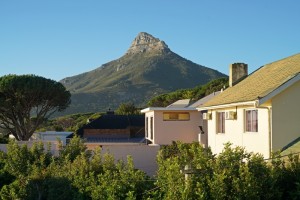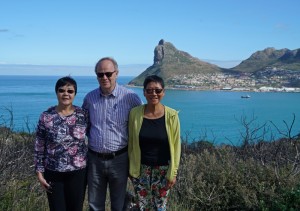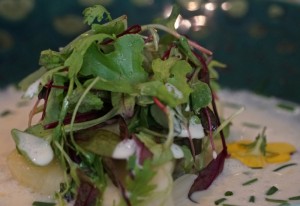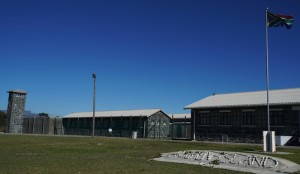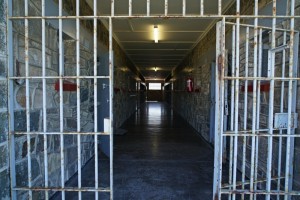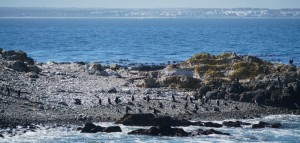Cape Town May 2- 5
Despite a tour to Cape Town, Pretoria and Johannesburg in the late 1990s, I hardly know South Africa. Hence I decide to join a 20-day tour that would take me from Cape Town to Johannesburg through the famous Garden Route, many national parks, Lesotho and Swaziland. By sheer luck, I meet up with friends from Hong Kong in Cape Town before joining the tour.
History
Located at the southernmost tip of the African continent, South Africa is the world’s 25th largest country with a land area of 1,221,037km² and a population of 55 million (2016 estimate). Its 2,800-km long coastline stretches along the South Atlantic and Indian Oceans.
Some of the world’s oldest archaeological and human fossil sites located in South Africa suggest that existence of various hominid species some three million years ago and habitation of modern humans for at least 170,000 years. In 1487, the Portuguese explorer Bartolomeu Dias led the first European voyage and landed on December 4 at the present day Walvis Bay in Namibia. In May 1488 on his way back to Portugal, Dias saw the Cape of Good Hope.
By the early 17th century, the English and Dutch merchants competed to oust the Portuguese from the lucrative spice trade. In 1652, Jan van Riebeeck established a refreshment station at the Cape of Good Hope which later became Cape Town on behalf of the Dutch East India Company. In 1795, the British took over the Cape to prevent it from falling under the control of the French First Republic. The British finally annexed the Cape Colony in 1806. The Boers (original Dutch, Flemish, German and French settlers) claimed land in the north and east of the country. Many Dutch settlers in the early 19th century moved to the Orange Free State and Transvaal regions. The Boers founded the Boer Republics: the South African Republic and the Orange Free State.
The discovery of diamonds in 1867 and gold in 1884 started the Mineral Revolution resulting in intensified European – South African efforts to gain control over the indigenous people (the Anglo-Zulu War in 1879) as well as struggles between the Boers and the British (first Boer War 1880-1881 and Second Boer War (1899-1902).
By late 19th century, white South Africans yearned for independence. Upon the enactment of the South African Act the Union of South Africa with nominal independence came into existence on May 31, 1910. In 1931, the Union gained fully sovereignty from the UK. In 1934, the South African Party (SAP) and National Party (NP) merged to form the United Party seeking reconciliation between Afrikaners and English-speaking “White”.
Racial segregation was a common phenomenon in colonies. After independence, the Natives’ Land Act of 1913 still severely restricted the ownership of land by blacks who at that time only controlled 7% of the country. In 1948, the NP which was elected to power strengthened the racial segregation and classified all peoples into three races and developed rights and limitations for each with the white minority (less than 20% of the population) controlling the black majority. This legally institutionalized segregation became known as apartheid.
![southafrica_provinces[1]](http://www.sarahontheroad.hk/wp-content/uploads/2016/05/southafrica_provinces1-300x280.gif) On May 11, 1931, the country following a referendum became a Republic on May 31, 1961. But apartheid continued causing widespread resistance and outcry both inside and outside the country. The African National Congress (ANC) founded in 1912 emerged as the leading political force. Many activists were arrested and imprisoned including Nelson Mandela (1918-2013) who was imprisoned for 27 years. Beginning in 1990 the NP government took steps to dismantle discrimination lifting the ban on the ANC and other political party. Finally, F. W. de Klerk opened bilateral discussions with Mandela in 1993 for a transition of policies and government. South Africa held its first universal elections in 1994 which the ANC won by an overwhelming majority and Mandela became the first black African President of the Republic of South Africa (1994-1999).
On May 11, 1931, the country following a referendum became a Republic on May 31, 1961. But apartheid continued causing widespread resistance and outcry both inside and outside the country. The African National Congress (ANC) founded in 1912 emerged as the leading political force. Many activists were arrested and imprisoned including Nelson Mandela (1918-2013) who was imprisoned for 27 years. Beginning in 1990 the NP government took steps to dismantle discrimination lifting the ban on the ANC and other political party. Finally, F. W. de Klerk opened bilateral discussions with Mandela in 1993 for a transition of policies and government. South Africa held its first universal elections in 1994 which the ANC won by an overwhelming majority and Mandela became the first black African President of the Republic of South Africa (1994-1999).
South Africa Today
The country divided into nine provinces, has a mixed economy with an abundant supply of natural resources. It is the world’s largest producer of platinum, gold and chromium and has the second largest economy in Africa after Nigeria with an estimated GDP and GDP per capita (nominal) for 2016 of $326.541 billion and $5,859 respectively.
As a multiethnic society, it encompasses a wide variety of cultures, languages and religions. According to the 2014 estimate, 80.2% of the population is black, 8.8% coloured, 8.4% white and 2.5% Asian. There are 11 official languages, three capitals namely Pretoria, Bloemfontein and Cape Town which are the executive, judicial and legislative capital respectively while the economic centre and the largest city is Johannesburg.
South Africa boasting eight World Heritage Sites including the Cradle of Humankind, Robben Island, Cape Floral Region in the Western Cape, iSimangaliso Wetland Park, Mapungubwe Kingdom, Ukhalamaba Drakensberg Park and Vredefort Dome (remnants of the largest and oldest meteorite crater) is a popular tourist destination. It is the first African country to host the soccer World Cup in 2010.
May 2 Monday (GMT+2): Doha, Qatar – Cape Town, South Africa
My plane touched down in Cape Town on schedule after 11:30am. I was excited to see Alice waiving at me when I came out with my luggage. Alice my boss twice in early 1980s and late 1990s, was on holiday with her husband Robert Footman, son Eric, sister Elisabeth and brother Henry to visit a charity organisation. We were met by Clive, the pastor and his wife Brenda. We discovered we would be arriving in Cape Town on the same date and time at our boss’s birthday party on April 14. I therefore booked a room in Villa Surprise close to their luxurious service apartment with fantastic views of Camps Bay.
As the reception at Villa Surprise was closed till 5pm, I had a leisure afternoon with my friends. The guesthouse is run by Rolf from Switzerland. I have a wonderful white-blue room with decorations all from the sea and amazing views of Signal Hill, the Table Mountain and 12 Apostles. I watched my first sunset in Cape Town with amazing rich and deep glittering golden orange hues.
At 6:30pm, they picked me up and we had dinner at Fish Market at V&A Waterfront with Clive and Brenda. Everything is reasonably cheap owing to flavourable exchange rate (HK$1=1.9ZAR). We had sushi and sashimi, a seafood platter and spare rib, wine and dessert.
May 3-5: Leisure Holiday in Cape Town
Cape Town is the most popular tourist destination in Africa attracting over 1.5 million international tourists a year. With a population of over 3.7million in the Metropolitan Area, it is the provincial capital of the Western Cape and the third most populous urban areas in South Africa.
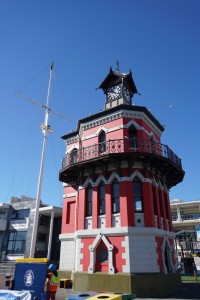 Famous for its harbour, the iconic Table Mountain, stunning landscape and amazing natural vegetation, it is a city of the past as well as the present with rich heritage. Bartolomeu Dias and Vasco da Gama sighted the Cape of Good Hope in 1486 in 1497 respectively and the Dutch East India Company established here a way-station for ships sailing to the Dutch East Indies. Following the Anglo-Dutch Treaty of 1814, Cape Town became the capital of the newly formed Cape Colony but its prosperity declined following the opening of the Suez Canal in 1869.
Famous for its harbour, the iconic Table Mountain, stunning landscape and amazing natural vegetation, it is a city of the past as well as the present with rich heritage. Bartolomeu Dias and Vasco da Gama sighted the Cape of Good Hope in 1486 in 1497 respectively and the Dutch East India Company established here a way-station for ships sailing to the Dutch East Indies. Following the Anglo-Dutch Treaty of 1814, Cape Town became the capital of the newly formed Cape Colony but its prosperity declined following the opening of the Suez Canal in 1869.
Cape Town reminds visitors of the dark history of South Africa during the days of apartheid. Following the Group Area Act which classified all areas according to race, District Six which was declared a white-only region in 1965, saw all housing demolished and over 60,000 residents were forcibly removed with many relocated to the Cape Flats and Lavender Hill. Robben Island, a former penitentiary island 7 km from the city and the prison where many famous political prisoners were kept for years, is a World Heritage Site attracting some 2,000 visitors a day.
May 3 Tuesday– We had a 35-km scenic drive to Hout Bay and Noordhoek a suburb of Cape Town located below Chapman’s Peak. The picturesque shoreline and the long wide sandy beach are impressive. We had an excellent and most value for money lunch at the Foodbarn. I had soup and grilled fish with sparkling wine and a red wine which cost just 400 ZAR as all dishes are 50% off for lunch on weekdays.
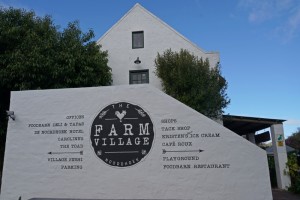 |
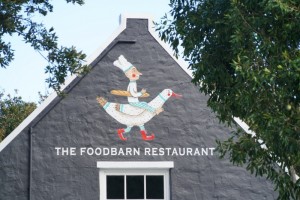 |
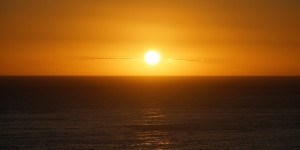 On our way back, we visited the factory of a well-known fabric shop where I paid 200 ZAR for a linen table cloth on sale with grey zebra prints. What a bargain! I was so full that I skipped dinner.
On our way back, we visited the factory of a well-known fabric shop where I paid 200 ZAR for a linen table cloth on sale with grey zebra prints. What a bargain! I was so full that I skipped dinner.
May 4 Wednesday– Accompanied by Clive, we spent the whole afternoon in Delft, one of the townships on the Cape Flat with a population of over 100,000. Like many formal and informal townships for the poor outside Cape Town, Delft has poor infrastructures and housing. Unemployment and crime remain serious problems.
Clive and Brenda established the organisation some 16 years ago. Today it employs nine locals to run a soup kitchen which prepares soup four days a week, a remedial class for children requiring special help with their studies and a homework class for over 50 students who drop in after school where they are given bread and a drink. The annual budget is about 1 million ZAR.
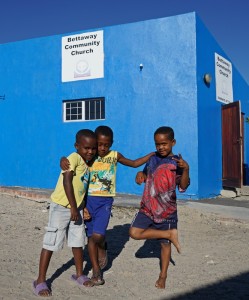 |
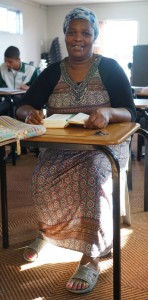 |
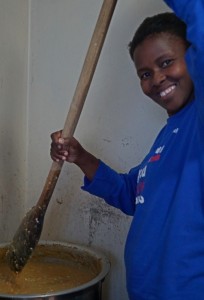 |
When walking past a secondary school, we asked whether we could go in to take a look. The school authority gave us the permission. There is no broken window though some of the classroom furniture can be replaced. A group of Class 12 students said proudly that they would be going to college in the summer.
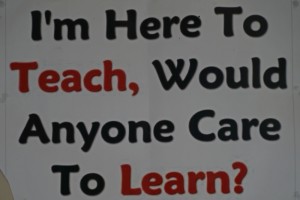 |
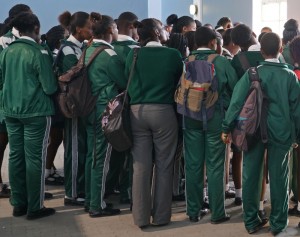 |
We also dropped by a community clinic that treats patients with drug problems and HIV in addition to a range of normal services. I have visited a few clinics and emergency rooms in Africa, Central and South America. I give it an above average rating for its management, cleanness and ambiance for a poor neighbourhood!
The Delft main premise (Bettaway Community Church) is used by students in the afternoon and for church-goers on Sundays. Soup that can feed over 400 persons is prepared in the kitchen and distributed in three locations. Clive showed us plans to expand the church and build a football pitch nearby. Between 5 and 6 pm, we followed Cline’s staff to distribute soup in Delft and Green Park. The soup was well cooked with lots of vegetables: it may be the only substantial meal for some of the people coming with their cups and containers. They are doing a good job!
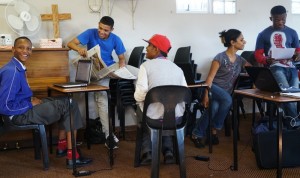 |
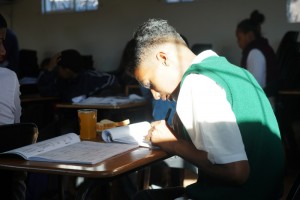 |
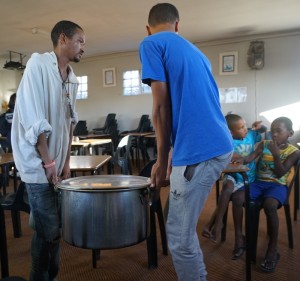 |
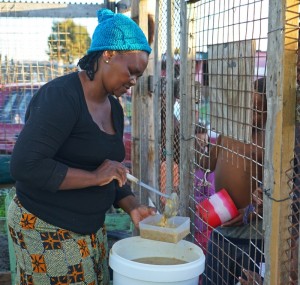 |
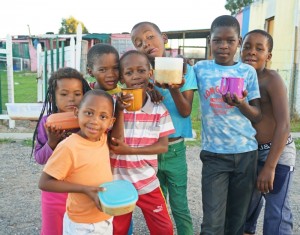 |
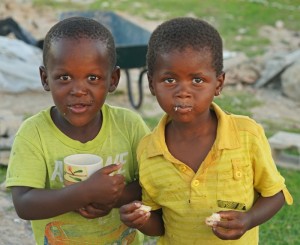 |
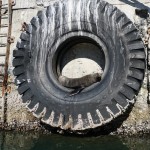 In the evening, we had dinner with Clive and Brenda in Camps Bay. The T-bone and sirloin steak is delicious and cheap. We all enjoyed the meat so much that we returned the next day.
In the evening, we had dinner with Clive and Brenda in Camps Bay. The T-bone and sirloin steak is delicious and cheap. We all enjoyed the meat so much that we returned the next day.
May 5 Thursday– While my friends were spending a day with their relatives, I went sightseeing on a tourist bus day pass (190 ZAR). I was in Cape Town in late 1990s with my best friend Lillian on an organised tour. But we only spent a few hours in V&A Waterfront and the Table Mountain. This time, I told myself not to leave without going to Robben Island (meaning seal island) to pay homage to Mandela and South Africans’ success in ending apartheid in dignity and peace. I began my day with a harbour cruise for half an hour.
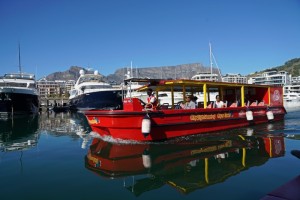 |
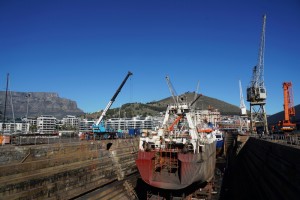 |
I paid 300 ZAR for a visit which takes about four hours. I booked a tour at 11am and had to take a ferry to the island. Upon arrival, I boarded a bus where the guide told us the history of the island (3.3km long north-south and 1.8 km wide with an area of 5.07 km²). It was first used for the isolation of mainly political prisoners in the 17th century. There are a few landmarks-
- The quarry where prisoners worked to cut stones to pave the roads on the island.
- The Moturu Kramat built in 1969 to commemorate Sayed Abdurahman Moturu, the Prince of Madura who was exiled to the island in the mid-1740s and died in 1754, is a sacred site for Muslim pilgrimage.
- The house where Robert Mangaliso Sobukwe (1924-1978), founder of the Pan Africanist Congress was kept in isolation.
- The village where some 200 people are still living on the island.
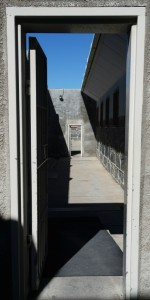 |
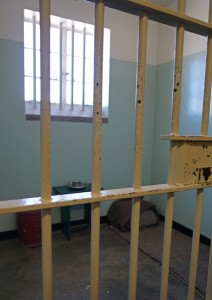 |
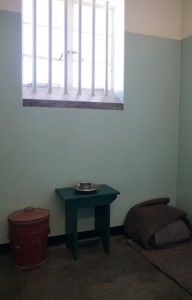 |
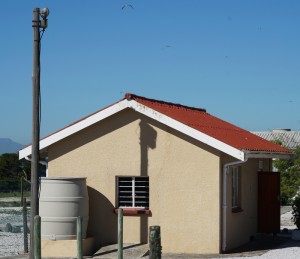 |
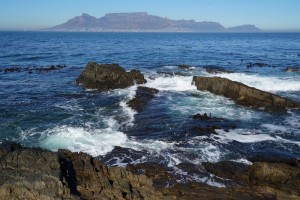 |
The bus tour ended with a coffee stop where affords the best view of Table Mountain. I also spotted some African penguins on a beach.
Then an ex-prisoner took us on a guided tour of the prison where Mandela was spent 18 of his 27 years of imprisonment before the fall of apartheid. We spent some time in the courtyard he and other prisoners worked and Cell 7 in Block A where Mandela slept on the floor in a cell about 50 square feet. We also went to see Block D where the Nambian prisoners were imprisoned. I am afraid our guide is incomprehensible and not a good story teller. What a pity!
It was 3pm when I was back to the V&A Waterfront. As I would be going out to dinner around 7pm, I simply took the red route tourist bus which took me to the Botanical Garden, Hout Bay and Campus Bay. It is a scenic route with good commentary about the history of District Six and the problem of informal townships springing around Cape Town. I was back to the hotel at 6pm in time to watch another beautiful sunset for the last time before leaving the city the following day.



